tow MAZDA MODEL CX-30 2019 (in English) Owner's Manual
[x] Cancel search | Manufacturer: MAZDA, Model Year: 2019, Model line: MODEL CX-30, Model: MAZDA MODEL CX-30 2019Pages: 683, PDF Size: 15.21 MB
Page 242 of 683
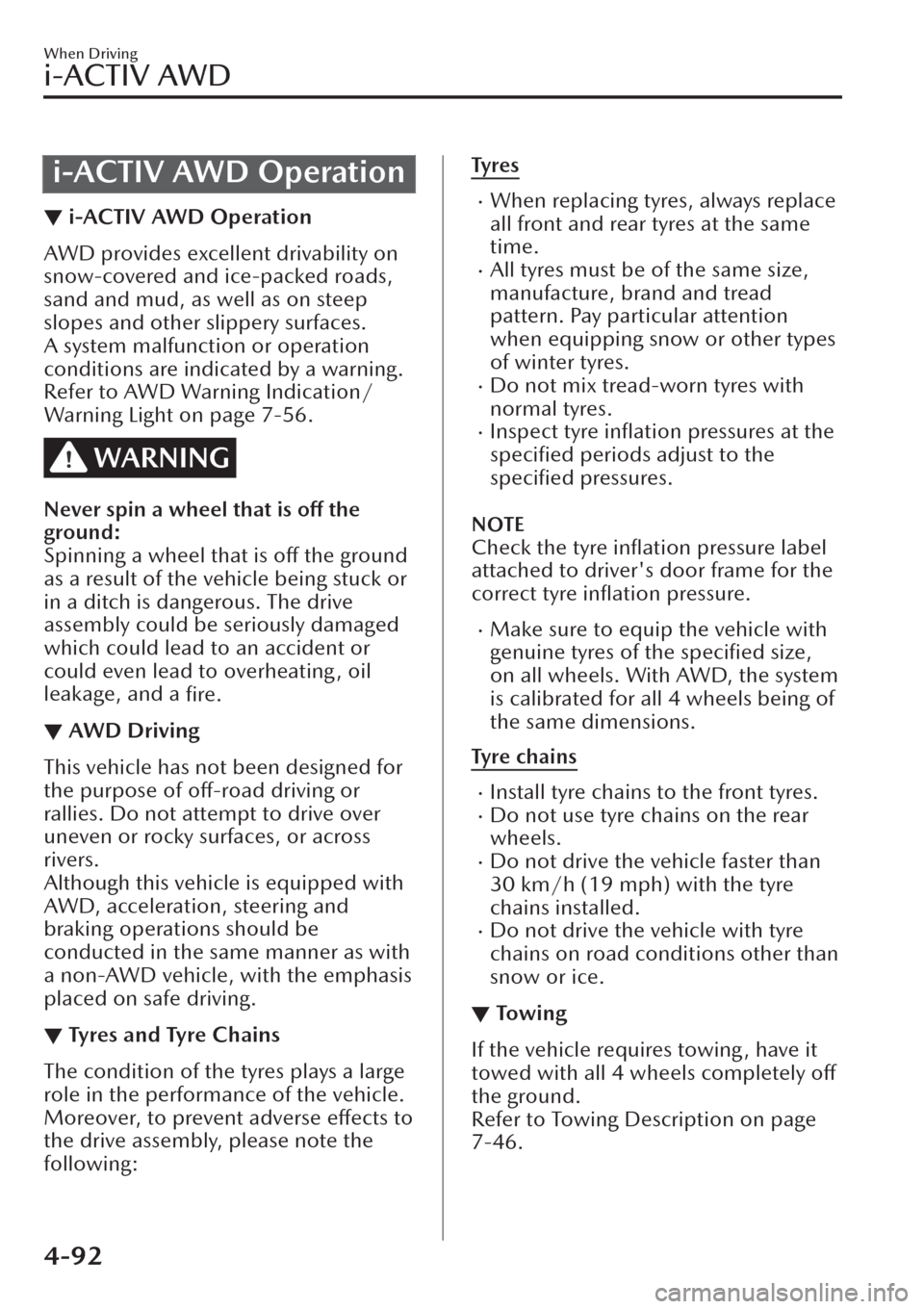
i-ACTIV AWD Operation
▼i-ACTIV AWD Operation
AWD provides excellent drivability on
snow-covered and ice-packed roads,
sand and mud, as well as on steep
slopes and other slippery surfaces.
A system malfunction or operation
conditions are indicated by a warning.
Refer to AWD Warning Indication/
Warning Light on page 7-56.
WARNING
Never spin a wheel that is off the
ground:
Spinning a wheel that is off the ground
as a result of the vehicle being stuck or
in a ditch is dangerous. The drive
assembly could be seriously damaged
which could lead to an accident or
could even lead to overheating, oil
leakage, and a
fire.
▼AWD Driving
This vehicle has not been designed for
the purpose of off-road driving or
rallies. Do not attempt to drive over
uneven or rocky surfaces, or across
rivers.
Although this vehicle is equipped with
AWD, acceleration, steering and
braking operations should be
conducted in the same manner as with
a non-AWD vehicle, with the emphasis
placed on safe driving.
▼Ty re s a n d Ty re C h a i n s
The condition of the tyres plays a large
role in the performance of the vehicle.
Moreover, to prevent adverse effects to
the drive assembly, please note the
following:
Ty re s
�xWhen replacing tyres, always replace
all front and rear tyres at the same
time.
�xAll tyres must be of the same size,
manufacture, brand and tread
pattern. Pay particular attention
when equipping snow or other types
of winter tyres.
�xDo not mix tread-worn tyres with
normal tyres.
�xInspect tyre
inflation pressures at the
specified periods adjust to the
specified pressures.
NOTE
Check the tyre
inflation pressure label
attached to driver's door frame for the
correct tyre
inflation pressure.
�xMake sure to equip the vehicle with
genuine tyres of the specified size,
on all wheels. With AWD, the system
is calibrated for all 4 wheels being of
the same dimensions.
Tyre chains
�xInstall tyre chains to the front tyres.�xDo not use tyre chains on the rear
wheels.
�xDo not drive the vehicle faster than
30 km/h (19 mph) with the tyre
chains installed.
�xDo not drive the vehicle with tyre
chains on road conditions other than
snow or ice.
▼To w i n g
If the vehicle requires towing, have it
towed with all 4 wheels completely
off
the ground.
Refer to Towing Description on page
7-46.
When Driving
i-ACTIV AWD
4-92
Page 249 of 683
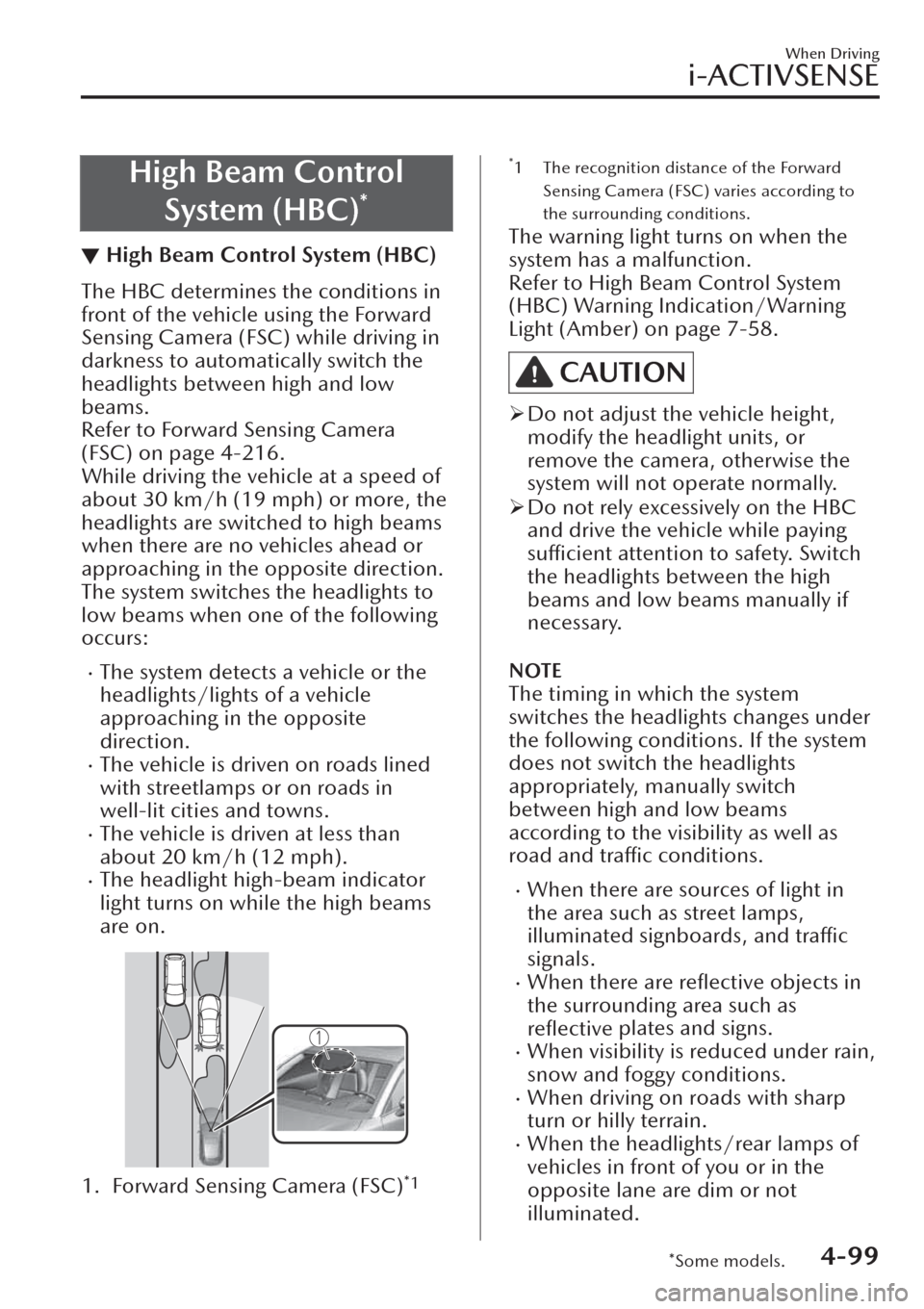
High Beam Control
System (HBC)
*
▼High Beam Control System (HBC)
The HBC determines the conditions in
front of the vehicle using the Forward
Sensing Camera (FSC) while driving in
darkness to automatically switch the
headlights between high and low
beams.
Refer to Forward Sensing Camera
(FSC) on page 4-216.
While driving the vehicle at a speed of
about 30 km/h (19 mph) or more, the
headlights are switched to high beams
when there are no vehicles ahead or
approaching in the opposite direction.
The system switches the headlights to
low beams when one of the following
occurs:
�xThe system detects a vehicle or the
headlights/lights of a vehicle
approaching in the opposite
direction.
�xThe vehicle is driven on roads lined
with streetlamps or on roads in
well-lit cities and towns.
�xThe vehicle is driven at less than
about 20 km/h (12 mph).
�xThe headlight high-beam indicator
light turns on while the high beams
are on.
1. Forward Sensing Camera (FSC)*1
*1 The recognition distance of the Forward
Sensing Camera (FSC) varies according to
the surrounding conditions.
The warning light turns on when the
system has a malfunction.
Refer to High Beam Control System
(HBC) Warning Indication/Warning
Light (Amber) on page 7-58.
CAUTION
�¾Do not adjust the vehicle height,
modify the headlight units, or
remove the camera, otherwise the
system will not operate normally.
�¾Do not rely excessively on the HBC
and drive the vehicle while paying
sufficient attention to safety. Switch
the headlights between the high
beams and low beams manually if
necessary.
NOTE
The timing in which the system
switches the headlights changes under
the following conditions. If the system
does not switch the headlights
appropriately, manually switch
between high and low beams
according to the visibility as well as
road and traffic conditions.
�xWhen there are sources of light in
the area such as street lamps,
illuminated signboards, and traffic
signals.
�xWhen there are reflective objects in
the surrounding area such as
reflective plates and signs.
�xWhen visibility is reduced under rain,
snow and foggy conditions.
�xWhen driving on roads with sharp
turn or hilly terrain.
�xWhen the headlights/rear lamps of
vehicles in front of you or in the
opposite lane are dim or not
illuminated.
When Driving
i-ACTIVSENSE
*Some models.4-99
Page 275 of 683
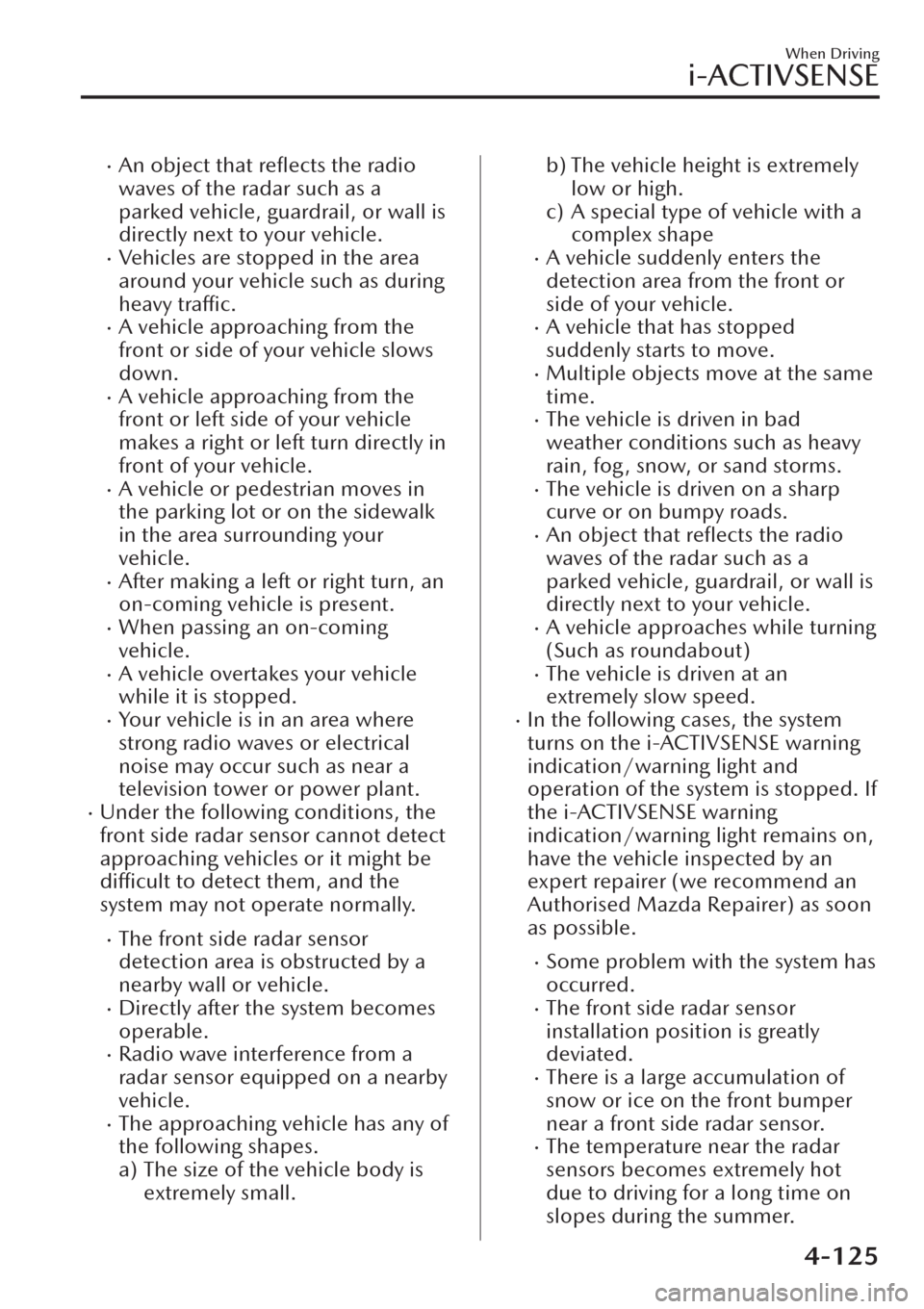
�xAn object that reflects the radio
waves of the radar such as a
parked vehicle, guardrail, or wall is
directly next to your vehicle.
�xVehicles are stopped in the area
around your vehicle such as during
heavy traffic.
�xA vehicle approaching from the
front or side of your vehicle slows
down.
�xA vehicle approaching from the
front or left side of your vehicle
makes a right or left turn directly in
front of your vehicle.
�xA vehicle or pedestrian moves in
the parking lot or on the sidewalk
in the area surrounding your
vehicle.
�xAfter making a left or right turn, an
on-coming vehicle is present.
�xWhen passing an on-coming
vehicle.
�xA vehicle overtakes your vehicle
while it is stopped.
�xYour vehicle is in an area where
strong radio waves or electrical
noise may occur such as near a
television tower or power plant.
�xUnder the following conditions, the
front side radar sensor cannot detect
approaching vehicles or it might be
difficult to detect them, and the
system may not operate normally.
�xThe front side radar sensor
detection area is obstructed by a
nearby wall or vehicle.
�xDirectly after the system becomes
operable.
�xRadio wave interference from a
radar sensor equipped on a nearby
vehicle.
�xThe approaching vehicle has any of
the following shapes.
a) The size of the vehicle body is
extremely small.
b) The vehicle height is extremely
low or high.
c) A special type of vehicle with a
complex shape
�xA vehicle suddenly enters the
detection area from the front or
side of your vehicle.
�xA vehicle that has stopped
suddenly starts to move.
�xMultiple objects move at the same
time.
�xThe vehicle is driven in bad
weather conditions such as heavy
rain, fog , snow, or sand storms.
�xThe vehicle is driven on a sharp
curve or on bumpy roads.
�xAn object that reflects the radio
waves of the radar such as a
parked vehicle, guardrail, or wall is
directly next to your vehicle.
�xA vehicle approaches while turning
(Such as roundabout)
�xThe vehicle is driven at an
extremely slow speed.
�xIn the following cases, the system
turns on the i-ACTIVSENSE warning
indication/warning light and
operation of the system is stopped. If
the i-ACTIVSENSE warning
indication/warning light remains on,
have the vehicle inspected by an
expert repairer (we recommend an
Authorised Mazda Repairer) as soon
as possible.
�xSome problem with the system has
occurred.
�xThe front side radar sensor
installation position is greatly
deviated.
�xThere is a large accumulation of
snow or ice on the front bumper
near a front side radar sensor.
�xThe temperature near the radar
sensors becomes extremely hot
due to driving for a long time on
slopes during the summer.
When Driving
i-ACTIVSENSE
4-125
Page 278 of 683
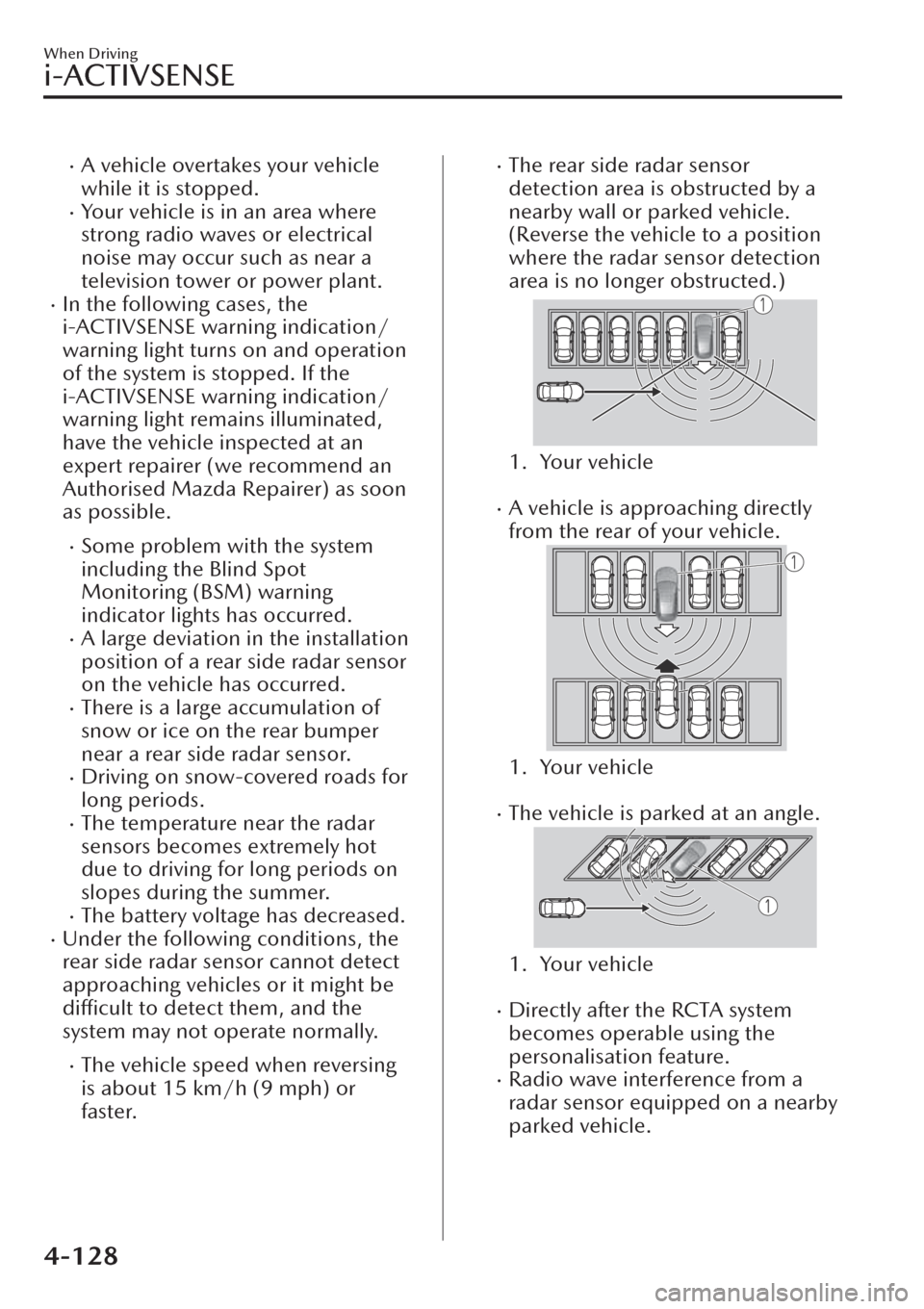
�xA vehicle overtakes your vehicle
while it is stopped.
�xYour vehicle is in an area where
strong radio waves or electrical
noise may occur such as near a
television tower or power plant.
�xIn the following cases, the
i-ACTIVSENSE warning indication/
warning light turns on and operation
of the system is stopped. If the
i-ACTIVSENSE warning indication/
warning light remains illuminated,
have the vehicle inspected at an
expert repairer (we recommend an
Authorised Mazda Repairer) as soon
as possible.
�xSome problem with the system
including the Blind Spot
Monitoring (BSM) warning
indicator lights has occurred.
�xA large deviation in the installation
position of a rear side radar sensor
on the vehicle has occurred.
�xThere is a large accumulation of
snow or ice on the rear bumper
near a rear side radar sensor.
�xDriving on snow-covered roads for
long periods.
�xThe temperature near the radar
sensors becomes extremely hot
due to driving for long periods on
slopes during the summer.
�xThe battery voltage has decreased.�xUnder the following conditions, the
rear side radar sensor cannot detect
approaching vehicles or it might be
difficult to detect them, and the
system may not operate normally.
�xThe vehicle speed when reversing
is about 15 km/h (9 mph) or
faster.
�xThe rear side radar sensor
detection area is obstructed by a
nearby wall or parked vehicle.
(Reverse the vehicle to a position
where the radar sensor detection
area is no longer obstructed.)
1. Your vehicle
�xA vehicle is approaching directly
from the rear of your vehicle.
1. Your vehicle
�xThe vehicle is parked at an angle.
1. Your vehicle
�xDirectly after the RCTA system
becomes operable using the
personalisation feature.
�xRadio wave interference from a
radar sensor equipped on a nearby
parked vehicle.
When Driving
i-ACTIVSENSE
4-128
Page 281 of 683

For safety purposes, switch the MRCC
system off when it is not being used.
Leaving the MRCC system turned on
when it is not in use is dangerous as it
could operate unexpectedly, resulting
in an accident.
CAUTION
�¾Turn the system off when the vehicle
is running on a chassis roller.
�¾If your vehicle is towed or you are
towing something , switch the MRCC
system off to prevent an unexpected
operation.
NOTE
�xThe MRCC system does not detect
the following as physical objects.
�xVehicles approaching in the
opposite direction
�xPedestrians�xStationary objects (stopped
vehicles, obstructions)
�xIf a vehicle ahead is travelling at an
extremely low speed, the system
may not detect it correctly.
�xIf there is a structure on the road or
an object (such as a monorail) at a
low height off the ground in front of
the vehicle, the system may operate.
Therefore, do not use the MRCC.
�xDo not use the MRCC system under
conditions in which close proximity
warnings are frequently activated.
�xDuring headway control travel, the
system accelerates and decelerates
your vehicle in conjunction with the
speed of the vehicle ahead.
However, if it is necessary to
accelerate for a lane change or if the
vehicle ahead brakes suddenly
causing you to close in on the vehicle
rapidly, accelerate using the
accelerator pedal or decelerate using
the brake pedal depending on the
conditions.
�xWhile the MRCC system is in use, it
does not cancel even if the selector
lever (automatic transmission)/shift
lever (manual transmission) is
operated and any intended engine
braking will not occur. If deceleration
is required, lower the vehicle speed
setting or depress the brake pedal.
�xWhile braking by the MRCC control
is operating, you might hear an
operation sound, however, this does
not indicate a problem.
�xThe brake lights turn on while
braking by the MRCC control is
operating , however, they may not
turn on while the vehicle is on a
down slope at the set vehicle speed
or travelling at a constant speed and
following a vehicle ahead.
�xStop the headway control function to
switch the system to the cruise
control function.
Refer to the Settings section in the
Mazda Connect Owner's Manual.
▼Mazda Radar Cruise Control
(MRCC) Display Indication
The MRCC setting status and operation
conditions are indicated on the
multi-information display and the
active driving display.
When Driving
i-ACTIVSENSE
4-131
Page 290 of 683

�¾When entering and exiting
interchanges, service areas, and
parking areas of highways (If you exit
a highway while headway control is
in use, the vehicle ahead will no
longer be tracked and your vehicle
may accelerate to the set speed).
�¾Slippery roads such as ice or
snow-bound roads (Tyres could spin
causing you to lose vehicle control,
or the stop hold control may not
operate.)
�¾Long , descending slopes (to
maintain distance between vehicles,
the system automatically and
continuously applies the brakes
which could result in the loss of
brake power.)
�¾Slopes with a steep gradient (The
vehicle ahead may not be detected
correctly, your vehicle may slide
while stopped by the stop hold
control, and it may accelerate
suddenly after it starts moving.)
�¾Two-wheeled vehicles such as
motorcycles or bicycles are ahead.
For safety purposes, switch the MRCC
with Stop & Go function system off
when it is not being used.
Leaving the MRCC with Stop & Go
function system turned on when it is
not in use is dangerous as it could
operate unexpectedly, resulting in an
accident.Do not get out of the vehicle while
the stop hold control is operating:
Getting out of the vehicle while the
stop hold control is operating is
dangerous as the vehicle may move
unexpectedly and result in an accident.
Before getting out of the vehicle,
switch the MRCC with Stop & Go
function system off, shift the selector
lever to the P position, and apply the
parking brake.
CAUTION
�¾If your vehicle is towed or you are
towing something, switch the MRCC
with Stop & Go function system off
to prevent an unexpected operation.
�¾Turn the system off when the vehicle
is running on a chassis roller.
NOTE
�xThe MRCC with Stop & Go function
system does not detect the following
as physical objects.
�xVehicles approaching in the
opposite direction
�xPedestrians�xStationary objects (stopped
vehicles, obstructions)
�xIf a vehicle ahead is travelling at an
extremely low speed, the system may
not detect it correctly.
�xIf there is a structure on the road or
an object (such as a monorail) at a
low height off the ground in front of
the vehicle, the system may operate.
Therefore, do not use the MRCC
with Stop & Go function.
�xDo not use the MRCC with Stop &
Go function system under conditions
in which close proximity warnings
are frequently activated.
When Driving
i-ACTIVSENSE
4-140
Page 299 of 683
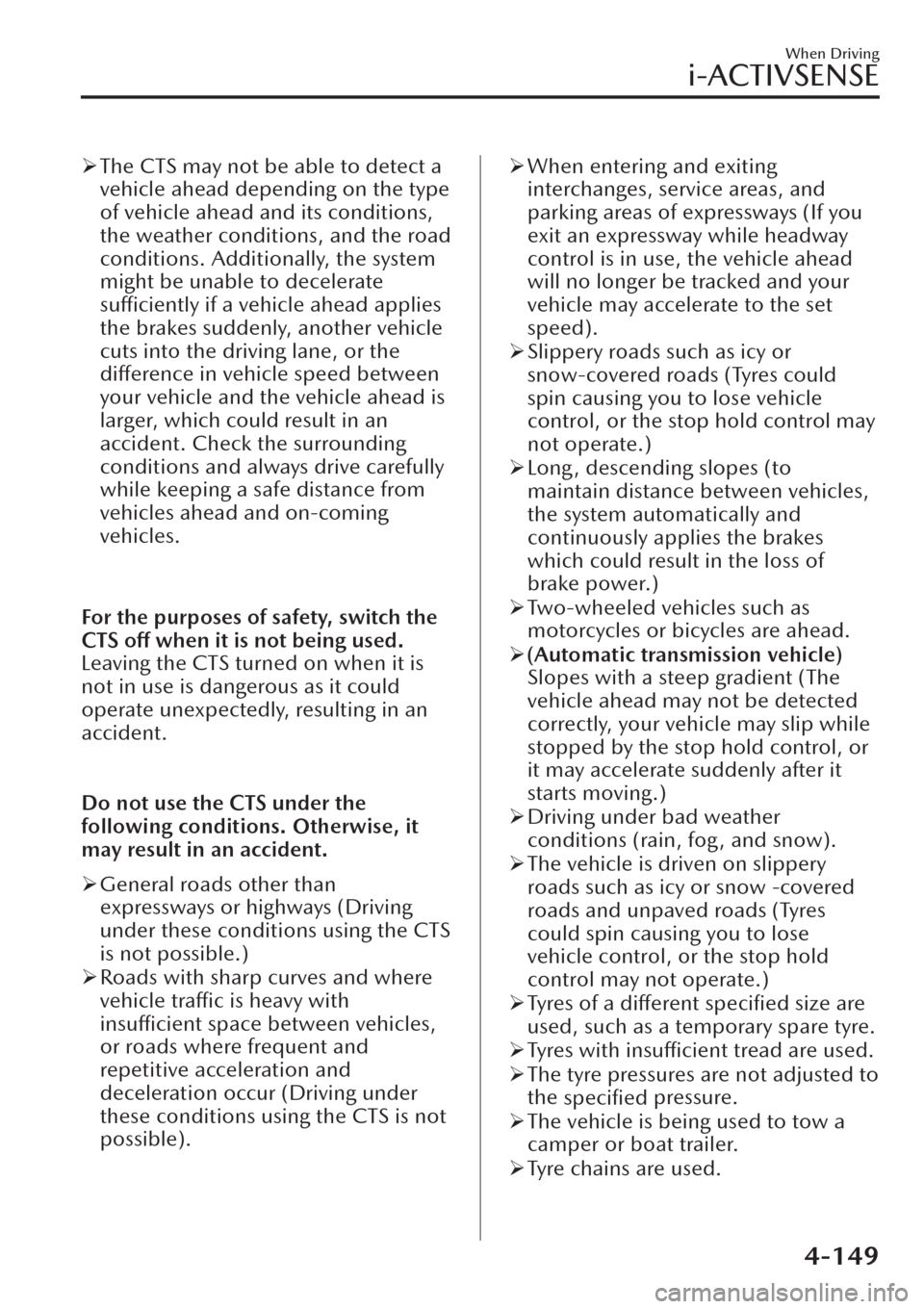
�¾The CTS may not be able to detect a
vehicle ahead depending on the type
of vehicle ahead and its conditions,
the weather conditions, and the road
conditions. Additionally, the system
might be unable to decelerate
sufficiently if a vehicle ahead applies
the brakes suddenly, another vehicle
cuts into the driving lane, or the
difference in vehicle speed between
your vehicle and the vehicle ahead is
larger, which could result in an
accident. Check the surrounding
conditions and always drive carefully
while keeping a safe distance from
vehicles ahead and on-coming
vehicles.
For the purposes of safety, switch the
CTS off when it is not being used.
Leaving the CTS turned on when it is
not in use is dangerous as it could
operate unexpectedly, resulting in an
accident.
Do not use the CTS under the
following conditions. Otherwise, it
may result in an accident.
�¾General roads other than
expressways or highways (Driving
under these conditions using the CTS
is not possible.)
�¾Roads with sharp curves and where
vehicle traffic is heavy with
insufficient space between vehicles,
or roads where frequent and
repetitive acceleration and
deceleration occur (Driving under
these conditions using the CTS is not
possible).�¾When entering and exiting
interchanges, service areas, and
parking areas of expressways (If you
exit an expressway while headway
control is in use, the vehicle ahead
will no longer be tracked and your
vehicle may accelerate to the set
speed).
�¾Slippery roads such as icy or
snow-covered roads (Tyres could
spin causing you to lose vehicle
control, or the stop hold control may
not operate.)
�¾Long , descending slopes (to
maintain distance between vehicles,
the system automatically and
continuously applies the brakes
which could result in the loss of
brake power.)
�¾Two-wheeled vehicles such as
motorcycles or bicycles are ahead.
�¾(Automatic transmission vehicle)
Slopes with a steep gradient (The
vehicle ahead may not be detected
correctly, your vehicle may slip while
stopped by the stop hold control, or
it may accelerate suddenly after it
starts moving.)
�¾Driving under bad weather
conditions (rain, fog , and snow).
�¾The vehicle is driven on slippery
roads such as icy or snow -covered
roads and unpaved roads (Tyres
could spin causing you to lose
vehicle control, or the stop hold
control may not operate.)
�¾Tyres of a different specified size are
used, such as a temporary spare tyre.
�¾Tyres with insufficient tread are used.
�¾The tyre pressures are not adjusted to
the
specified pressure.
�¾The vehicle is being used to tow a
camper or boat trailer.
�¾Tyre chains are used.
When Driving
i-ACTIVSENSE
4-149
Page 313 of 683
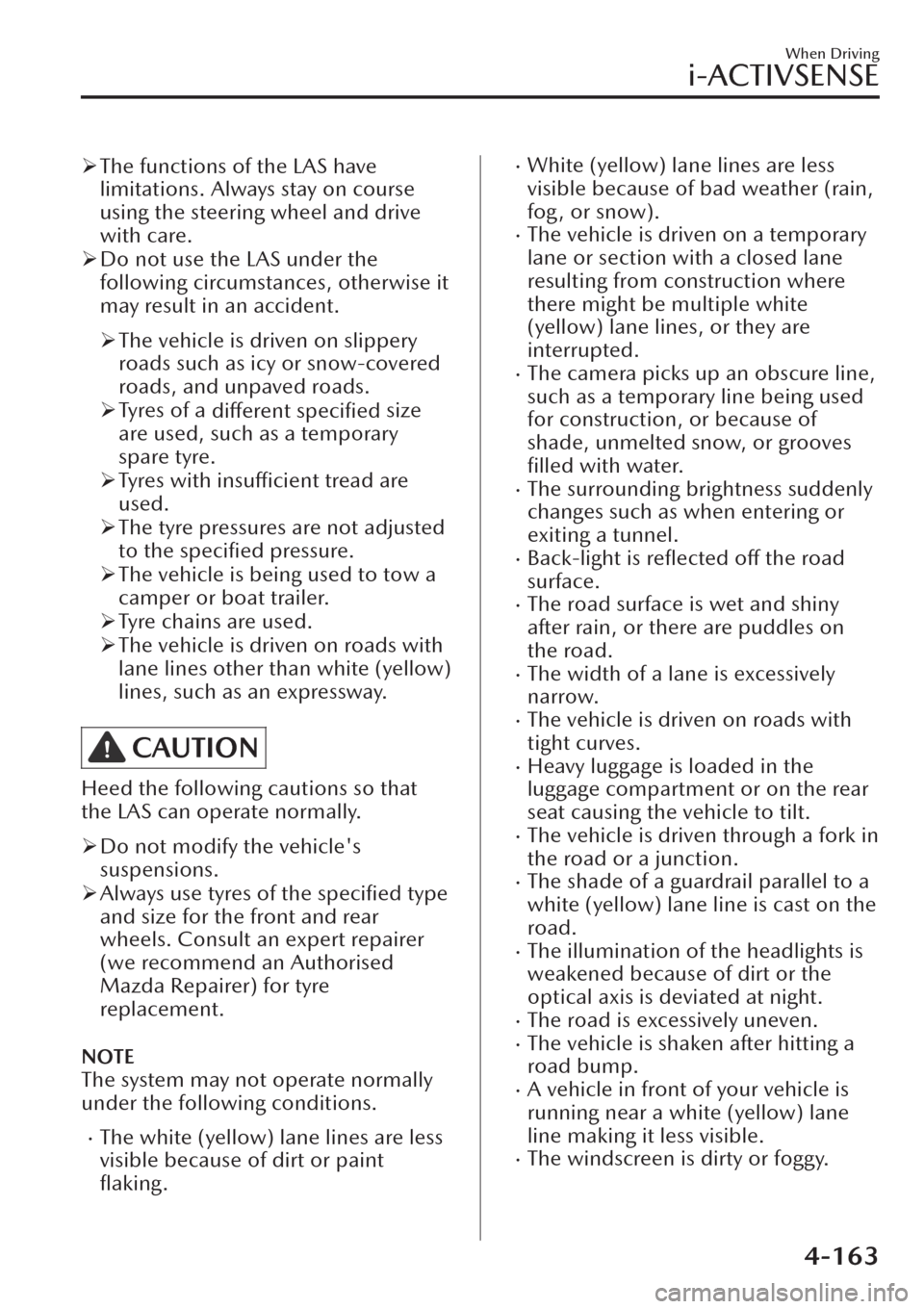
�¾The functions of the LAS have
limitations. Always stay on course
using the steering wheel and drive
with care.
�¾Do not use the LAS under the
following circumstances, otherwise it
may result in an accident.
�¾The vehicle is driven on slippery
roads such as icy or snow-covered
roads, and unpaved roads.
�¾Tyres of a
different
specified size
are used, such as a temporary
spare tyre.
�¾Tyres with
insufficient tread are
used.
�¾The tyre pressures are not adjusted
to the
specified pressure.
�¾The vehicle is being used to tow a
camper or boat trailer.
�¾Tyre chains are used.
�¾The vehicle is driven on roads with
lane lines other than white (yellow)
lines, such as an expressway.
CAUTION
Heed the following cautions so that
the LAS can operate normally.
�¾Do not modify the vehicle's
suspensions.
�¾Always use tyres of the specified type
and size for the front and rear
wheels. Consult an expert repairer
(we recommend an Authorised
Mazda Repairer) for tyre
replacement.
NOTE
The system may not operate normally
under the following conditions.
�xThe white (yellow) lane lines are less
visible because of dirt or paint
flaking.
�xWhite (yellow) lane lines are less
visible because of bad weather (rain,
fog, or snow).
�xThe vehicle is driven on a temporary
lane or section with a closed lane
resulting from construction where
there might be multiple white
(yellow) lane lines, or they are
interrupted.
�xThe camera picks up an obscure line,
such as a temporary line being used
for construction, or because of
shade, unmelted snow, or grooves
filled with water.
�xThe surrounding brightness suddenly
changes such as when entering or
exiting a tunnel.
�xBack-light is reflected off the road
surface.
�xThe road surface is wet and shiny
after rain, or there are puddles on
the road.
�xThe width of a lane is excessively
narrow.
�xThe vehicle is driven on roads with
tight curves.
�xHeavy luggage is loaded in the
luggage compartment or on the rear
seat causing the vehicle to tilt.
�xThe vehicle is driven through a fork in
the road or a junction.
�xThe shade of a guardrail parallel to a
white (yellow) lane line is cast on the
road.
�xThe illumination of the headlights is
weakened because of dirt or the
optical axis is deviated at night.
�xThe road is excessively uneven.�xThe vehicle is shaken after hitting a
road bump.
�xA vehicle in front of your vehicle is
running near a white (yellow) lane
line making it less visible.
�xThe windscreen is dirty or foggy.
When Driving
i-ACTIVSENSE
4-163
Page 325 of 683
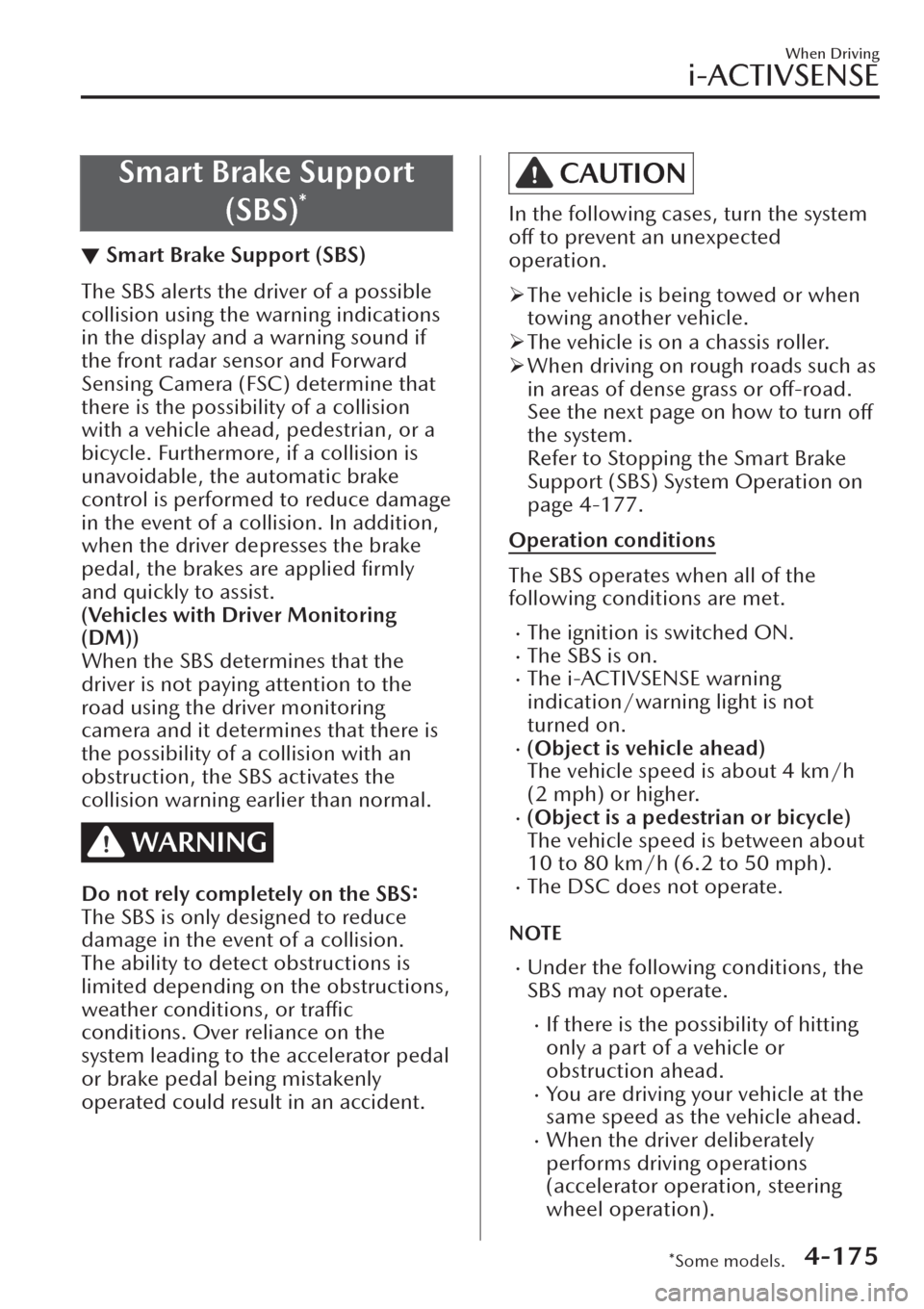
Smart Brake Support
(SBS)
*
▼Smart Brake Support (SBS)
The SBS alerts the driver of a possible
collision using the warning indications
in the display and a warning sound if
the front radar sensor and Forward
Sensing Camera (FSC) determine that
there is the possibility of a collision
with a vehicle ahead, pedestrian, or a
bicycle. Furthermore, if a collision is
unavoidable, the automatic brake
control is performed to reduce damage
in the event of a collision. In addition,
when the driver depresses the brake
pedal, the brakes are applied firmly
and quickly to assist.
(Vehicles with Driver Monitoring
(DM))
When the SBS determines that the
driver is not paying attention to the
road using the driver monitoring
camera and it determines that there is
the possibility of a collision with an
obstruction, the SBS activates the
collision warning earlier than normal.
WARNING
Do not rely completely on the
SBS:
The SBS is only designed to reduce
damage in the event of a collision.
The ability to detect obstructions is
limited depending on the obstructions,
weather conditions, or
traffic
conditions. Over reliance on the
system leading to the accelerator pedal
or brake pedal being mistakenly
operated could result in an accident.
CAUTION
In the following cases, turn the system
off to prevent an unexpected
operation.
�¾The vehicle is being towed or when
towing another vehicle.
�¾The vehicle is on a chassis roller.
�¾When driving on rough roads such as
in areas of dense grass or off-road.
See the next page on how to turn
off
the system.
Refer to Stopping the Smart Brake
Support (SBS) System Operation on
page 4-177.
Operation conditions
The SBS operates when all of the
following conditions are met.
�xThe ignition is switched ON.�xThe SBS is on.�xThe i-ACTIVSENSE warning
indication/warning light is not
turned on.
�x(Object is vehicle ahead)
The vehicle speed is about 4 km/h
(2 mph) or higher.
�x(Object is a pedestrian or bicycle)
The vehicle speed is between about
10 to 80 km/h (6.2 to 50 mph).
�xThe DSC does not operate.
NOTE
�xUnder the following conditions, the
SBS may not operate.
�xIf there is the possibility of hitting
only a part of a vehicle or
obstruction ahead.
�xYou are driving your vehicle at the
same speed as the vehicle ahead.
�xWhen the driver deliberately
performs driving operations
(accelerator operation, steering
wheel operation).
When Driving
i-ACTIVSENSE
*Some models.4-175
Page 368 of 683
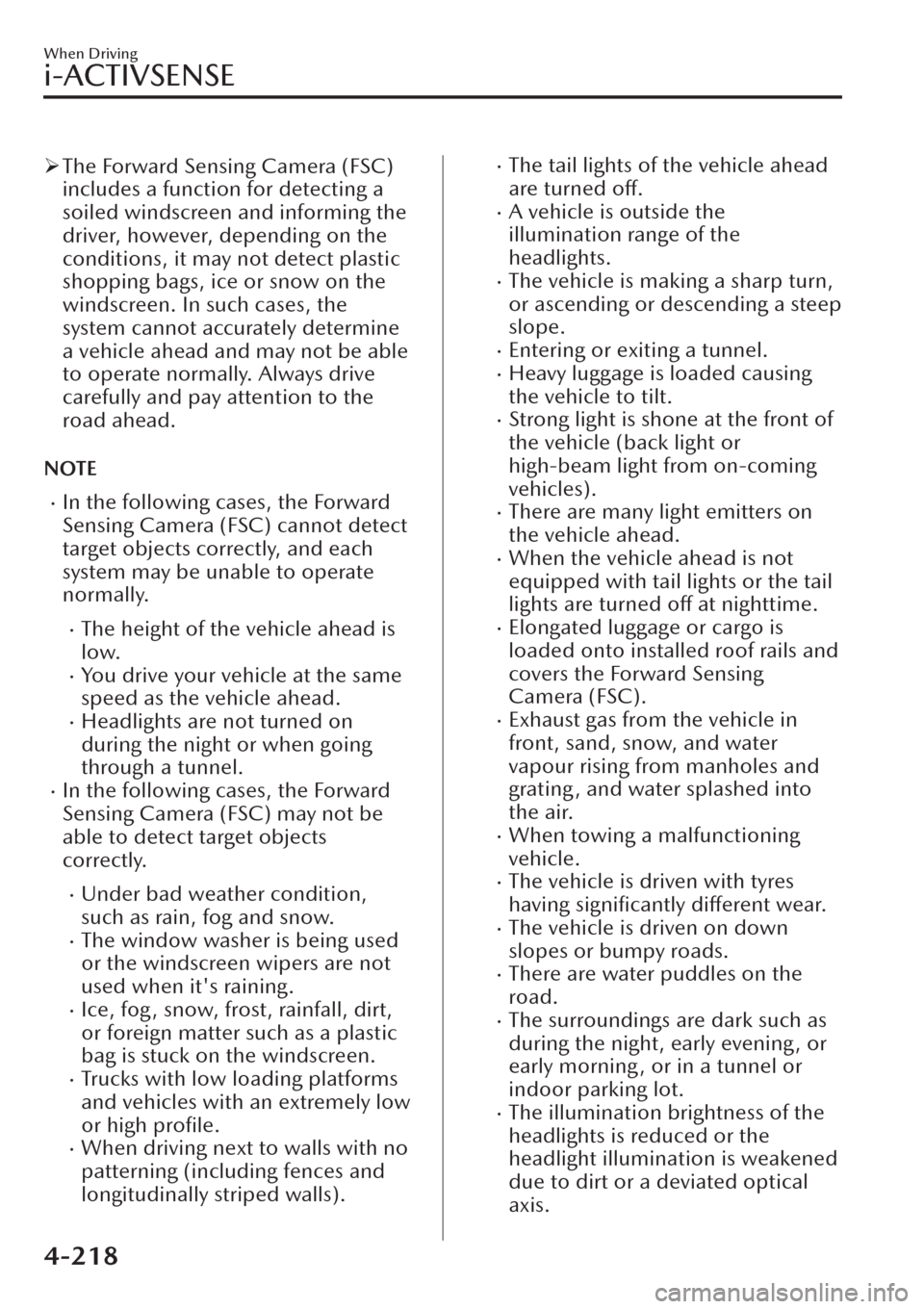
�¾The Forward Sensing Camera (FSC)
includes a function for detecting a
soiled windscreen and informing the
driver, however, depending on the
conditions, it may not detect plastic
shopping bags, ice or snow on the
windscreen. In such cases, the
system cannot accurately determine
a vehicle ahead and may not be able
to operate normally. Always drive
carefully and pay attention to the
road ahead.
NOTE
�xIn the following cases, the Forward
Sensing Camera (FSC) cannot detect
target objects correctly, and each
system may be unable to operate
normally.
�xThe height of the vehicle ahead is
low.
�xYou drive your vehicle at the same
speed as the vehicle ahead.
�xHeadlights are not turned on
during the night or when going
through a tunnel.
�xIn the following cases, the Forward
Sensing Camera (FSC) may not be
able to detect target objects
correctly.
�xUnder bad weather condition,
such as rain, fog and snow.
�xThe window washer is being used
or the windscreen wipers are not
used when it's raining.
�xIce, fog, snow, frost, rainfall, dirt,
or foreign matter such as a plastic
bag is stuck on the windscreen.
�xTrucks with low loading platforms
and vehicles with an extremely low
or high profile.
�xWhen driving next to walls with no
patterning (including fences and
longitudinally striped walls).
�xThe tail lights of the vehicle ahead
are turned off.
�xA vehicle is outside the
illumination range of the
headlights.
�xThe vehicle is making a sharp turn,
or ascending or descending a steep
slope.
�xEntering or exiting a tunnel.�xHeavy luggage is loaded causing
the vehicle to tilt.
�xStrong light is shone at the front of
the vehicle (back light or
high-beam light from on-coming
vehicles).
�xThere are many light emitters on
the vehicle ahead.
�xWhen the vehicle ahead is not
equipped with tail lights or the tail
lights are turned off at nighttime.
�xElongated luggage or cargo is
loaded onto installed roof rails and
covers the Forward Sensing
Camera (FSC).
�xExhaust gas from the vehicle in
front, sand, snow, and water
vapour rising from manholes and
grating , and water splashed into
the air.
�xWhen towing a malfunctioning
vehicle.
�xThe vehicle is driven with tyres
having significantly different wear.
�xThe vehicle is driven on down
slopes or bumpy roads.
�xThere are water puddles on the
road.
�xThe surroundings are dark such as
during the night, early evening, or
early morning , or in a tunnel or
indoor parking lot.
�xThe illumination brightness of the
headlights is reduced or the
headlight illumination is weakened
due to dirt or a deviated optical
axis.
When Driving
i-ACTIVSENSE
4-218